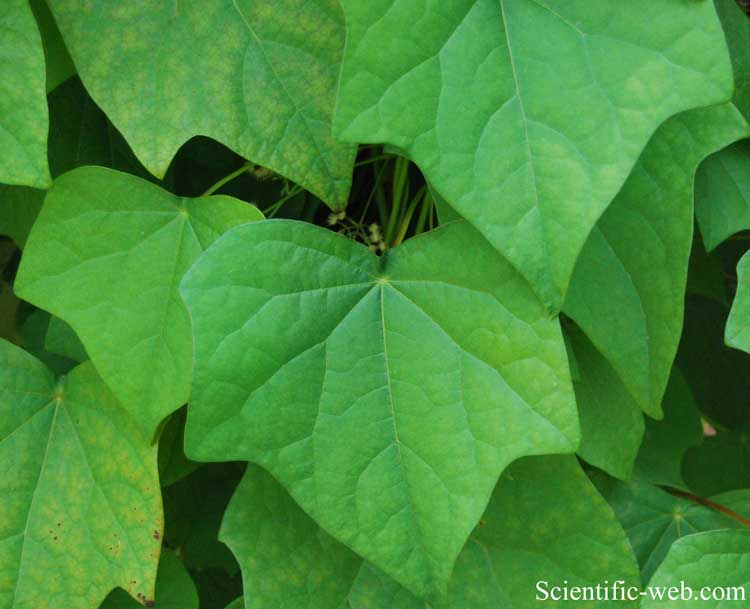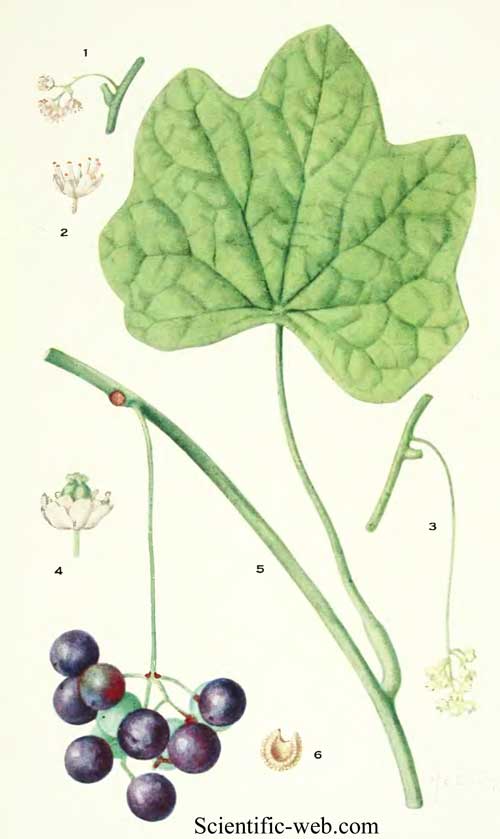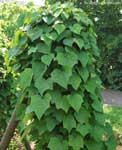
Menispermum canadense , Photo: Michael Lahanas
Classification System: APG IV
Superregnum: Eukaryota
Regnum: Plantae
Cladus: Angiosperms
Cladus: Eudicots
Ordo: Ranunculales
Familia: Menispermaceae
Subfamilia: Menispermoideae
Tribus: Menispermeae
Genus: Menispermum
Species: Menispermum canadense
Name
Menispermum canadense L., Sp. Pl. 1: 340. 1753.
Synonymy
Heterotypic
Menispermum mexicanum Rose, Contr. U.S. Natl. Herb. 13(9): 302. 1911.

Menispermum canadense
References
Primary references
Linnaeus, C. 1753. Species plantarum, exhibentes plantas rite cognitas, ad genera relatas, cum differentiis specificis, nominibus trivialibus, synonymis selectis, locis natalibus, secundum systema sexuale digestas. Tomus I. Pp. [I–XII], 1–560. Impensis Laurentii Salvii, Holmiae [Stockholm]. BHL Reference page.
Additional references
Calderón de Rzedowski, G. 1999. Menispermaceae. In Flora del Bajío, Fasc. 72. 13 pp. Instituto de Ecología, A.C., Pátzcuaro, Michoacán, México. BHL PDF Reference page.
Rhodes, D.G. 1997. 18. Menispermaceae Jussieu. Pp. 295–299 in Flora of North America, Vol. 3, Magnoliophyta: Magnoliidae and Hamamelidae. Oxford University Press, New York, Oxford. ISBN 0-19-511246-6. Online Reference page.
Links
International Plant Names Index. 2019. Menispermum canadense. Published online. Accessed: 03 February 2019.
Global Biodiversity Information Facility. 2019. GBIF Backbone Taxonomy. Checklist dataset. Taxon: Menispermum canadense.
USDA, ARS, Germplasm Resources Information Network. Menispermum canadense in the Germplasm Resources Information Network (GRIN), U.S. Department of Agriculture Agricultural Research Service. Accessed: 2019-02-03.
Hassler, M. 2019. Menispermum canadense. World Plants: Synonymic Checklists of the Vascular Plants of the World In: Roskovh, Y., Abucay, L., Orrell, T., Nicolson, D., Bailly, N., Kirk, P., Bourgoin, T., DeWalt, R.E., Decock, W., De Wever, A., Nieukerken, E. van, Zarucchi, J. & Penev, L., eds. 2019. Species 2000 & ITIS Catalogue of Life. Published online. Accessed: 2019 February 03. Reference page.
Tropicos.org 2019. Menispermum canadense. Missouri Botanical Garden. Published online. Accessed: 03 February 2019.
Vernacular names
English: Canada moonseed
suomi: Kanadankilpikierto
Menispermum canadense, the Canadian moonseed, common moonseed, or yellow parilla, is a flowering plant in the family Menispermaceae, native to eastern North America, from southern Canada south to northern Florida, and from the Atlantic coast west to Manitoba and Texas.[3] It occurs in thickets, moist woods, and the banks of streams.
Description
It is a woody climbing vine growing to 6 metres (20 feet) tall. The leaves are palmately lobed, 5–20 centimetres (2–8 inches) in diameter with 3–7 shallow lobes, occasionally rounded and unlobed. The fruit are produced in 6–10 cm (2+1⁄4–4 in) diameter clusters of purple-black berries, each berry is 1–1.5 cm in diameter. The seed inside the berry resembles a crescent moon, and is responsible for the common name. The fruit is ripe between September and October, the same general time frame in which wild grapes are ripe. Both the leaves and fruit resemble those of grapes; confusion can be dangerous as moonseed fruit is poisonous.
The root is a rhizome, so one specimen can form colonies of genetically identical plants.
Toxicity
All parts of these plants are known to be poisonous.[4] The principal toxin is the alkaloid dauricine.[5] The fruit of Canada Moonseed are poisonous and can be fatal. While foraging for wild grapes one should examine the seeds of the fruit to make sure one is not eating moonseeds: moonseeds have a single crescent-shaped seed, while grapes have round seeds. Differences in taste should also be an indicator of whether or not a specimen is grape or moonseed, moonseeds have a taste that is described as "rank". Also, the moonseed vine lacks tendrils, whilst the vine of the wild grape has forked tendrils.[6]
Uses
The Cherokee used moonseed as a laxative, and as a gynecological and venereal aid. The root was used for skin diseases. The Lenape used it in a salve for sores on the skin.[7] It has been used for a variety of medicinal uses by Americans of European descent.[8]
References
Jaume Saint-Hilaire, Jean Henri (1825) Menispermum canadense, (caption: MENISPERME DU CANADA) from Traite des arbrisseaux et des arbustes cultives en France et en pleine terre. Paris : chez l'auteur, 1825, page 104.
"The Plant List: A Working List of All Plant Species". Retrieved 7 December 2014.
"Menispermum canadense". Flora of North America.
FDA Poisonous Plant Database
"Menispermum canadense". Poisonous Plants of North Carolina, Alice B. Russell Department of Horticultural Science; James W. Hardin, Larry Grand, and Angela Fraser. North Carolina State University. Archived from the original on 2009-01-16. Retrieved 2009-04-09.
Peterson, Lee, "A Field Guide to Edible Wild Plants of Eastern and Central North America", p. 50, Houghton Mifflin Company, New York City, accessed 22 November 2010. ISBN 0-395-20445-3
Native American Ethnobotany Database (University of Michigan – Dearborn): Moonseed
"Dr. Duke's Database of USDA GRIN Taxonomy: Canadian Moonseed". Archived from the original on 2015-09-23. Retrieved 2007-03-07.
Retrieved from "http://en.wikipedia.org/"
All text is available under the terms of the GNU Free Documentation License


